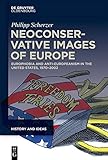Neoconservative Images of Europe : Europhobia and Anti-Europeanism in the United States, 1970–2002 / Philipp Scherzer.
Material type: TextSeries: History and Ideas : New Perspectives in European Studies ; 2Publisher: München ; Wien : De Gruyter Oldenbourg, [2022]Copyright date: ©2022Description: 1 online resource (IX, 385 p.)Content type:
TextSeries: History and Ideas : New Perspectives in European Studies ; 2Publisher: München ; Wien : De Gruyter Oldenbourg, [2022]Copyright date: ©2022Description: 1 online resource (IX, 385 p.)Content type: - 9783110762686
- 9783110764017
- 9783110763966
- D1065.U5 S2745 2022
- online - DeGruyter
- Issued also in print.
| Item type | Current library | Call number | URL | Status | Notes | Barcode | |
|---|---|---|---|---|---|---|---|
 eBook
eBook
|
Biblioteca "Angelicum" Pont. Univ. S.Tommaso d'Aquino Nuvola online | online - DeGruyter (Browse shelf(Opens below)) | Online access | Not for loan (Accesso limitato) | Accesso per gli utenti autorizzati / Access for authorized users | (dgr)9783110763966 |
Diss. Uni Mannheim 2021.
Frontmatter -- Acknowledgements -- Contents -- 1 Introduction -- 2 Anti-Europeanism: A Historical Overview -- 3 Understanding Neoconservatism -- 4 Images of Europe in Second-Age Neoconservatism, 1970–1992 -- 5 Images of Europe in Third-Age Neoconservatism, 1990–2002 -- 6 Conclusion -- 7 Bibliography -- Index
restricted access online access with authorization star
http://purl.org/coar/access_right/c_16ec
While in the last twenty years perceptions of Europe have been subjected to detailed historical scrutiny, American images of the Old World have been almost wantonly neglected. As a response to this scholarly desideratum, this pioneering study analyzes neoconservative images of Europe since the 1970s on the basis of an extensive collection of sources. With fresh insight into the evolution of American images of Europe as well as into the history of U.S. neoconservatism, the book appeals to readers familiar and new to the subject matters alike. The study explores how, beginning in the early 1970s, ideas of the United States as an anti-Europe have permeated neoconservative writing and shaped their self-images and political agitation. The choice of periodization and investigated personnel enables the author to refute popular claims that widespread Euro-critical sentiment in the United Studies during the early 21st century – considerably ignited by neoconservatives – was a distinct post-Cold War phenomenon. Instead, the analysis reveals that the fiery rhetoric in the context of the Iraq War debates was merely the climax of a decade-old development.
Issued also in print.
Mode of access: Internet via World Wide Web.
In English.
Description based on online resource; title from PDF title page (publisher's Web site, viewed 29. Mai 2023)


